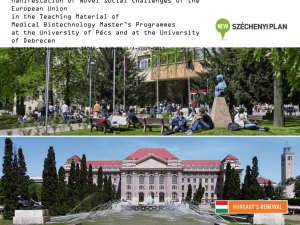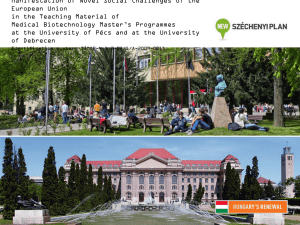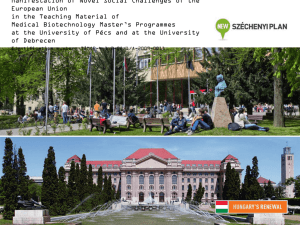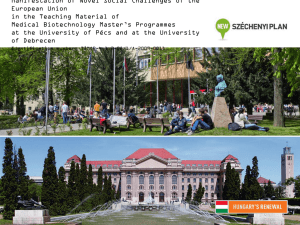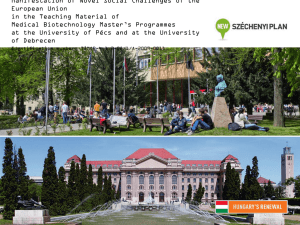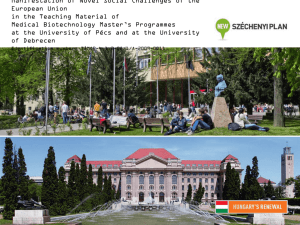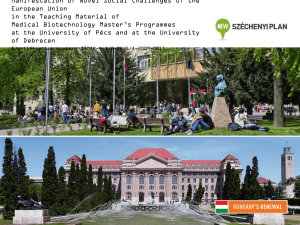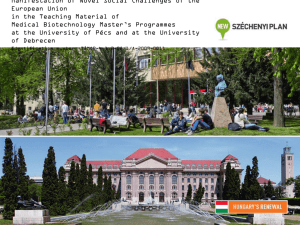Creutzfeldt-Jakob disease
advertisement
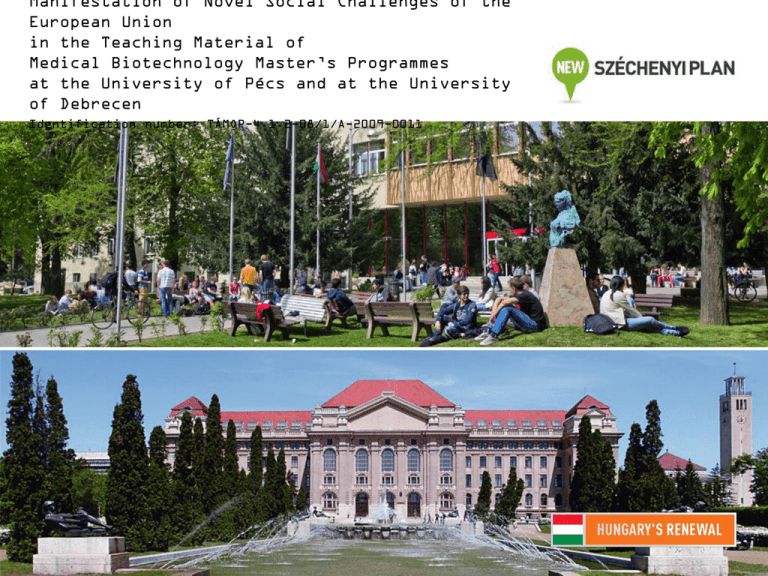
Manifestation of Novel Social Challenges of the European Union in the Teaching Material of Medical Biotechnology Master’s Programmes at the University of Pécs and at the University of Debrecen Identification number: TÁMOP-4.1.2-08/1/A-2009-0011 Manifestation of Novel Social Challenges of the European Union in the Teaching Material of Medical Biotechnology Master’s Programmes at the University of Pécs and at the University of Debrecen Identification number: TÁMOP-4.1.2-08/1/A-2009-0011 Márta Balaskó and Gyula Bakó Molecular and Clinical Basics of Gerontology – Lecture 17 NEUROLOGICAL DISORDERS IN THE ELERLY PART II The most common agingassociated neurological disorders (outline) TÁMOP-4.1.2-08/1/A-2009-0011 • Disorders of cerebral blood flow (stroke) • Neurodegenerative diseases affecting motor (and later cognitive) functions (e.g. Parkinson’s diasease) • Other, more frequent neurological disorders also present in old individuals with high prevalence: - myasthenia gravis - headache - dizziness (vertigo) in the elderly Neurodegenerative diseases affecting motor functions: classification TÁMOP-4.1.2-08/1/A-2009-0011 Earlier definitions: extrapyramidal disease, diseases of the basal ganglia Types: • Hypokinetic syndromes - Parkinson’s disease - Symptomatic parkinson syndromes - Multiple system atrophy • Hyperkinetic syndromes - Huntington chorea - Creutzfeldt-Jakob disease TÁMOP-4.1.2-08/1/A-2009-0011 Neurodegenerative diseases affecting motor functions Parkinson’s diasease Movement-related disease of unknown origin including shaking, rigidity, slowness of movement and difficulty with walking with dementia in the later phases. Huntington-chorea A neurodegenerative autosomal dominant genetic disorder that affects muscle coordination (with abnormal involuntary writhing movements = chorea) with cognitive decline and dementia. Parkinson’s disease: etiology prevalence TÁMOP-4.1.2-08/1/A-2009-0011 • A disease with progressive movement disorder • Special progressive cell death of the substantia nigra – with consequent dopamine deficiency • The origin of the cellular damage is unknown Risk factors: • AGE • Noxious effects (CO poisoning, infections, pesticides) • Mutations of the tau-gene Prevalence: • 100-200/100,000 population TÁMOP-4.1.2-08/1/A-2009-0011 Neurotransmitter imbalance in Parkinson’s disease Balance between dopamine and glutamate/acetylcholine Glutamate Acetylchol Dopamine Imbalance as a result of dopamine deficiency Glutamate Acetylchol Dopamine TÁMOP-4.1.2-08/1/A-2009-0011 Parkinson’s disease: early symptoms Symptoms: • Asymmetry: one-sided motor symptoms - tremor (at rest and aggravated by sustained effort), - rigidity of muscles (cogwheel phenomenon upon passive movement of limbs), - hypo- and bradykinesis (difficulty in initiating movement and getting frozen during the course of it), - lack of expression in the face (mask-like face, diminished eye blinking) - postural abnormalities - slow and monotonous speech • Upon levodopa administration symptoms TÁMOP-4.1.2-08/1/A-2009-0011 Parkinson’s disease: late symptoms Motor functions • postural instability (after 8-10 years) Autonomic functions • seborrheic oily skin • orthostatic hypotension • gastrointestinal disorders (dysphagia, constipation) • sphincter disturbances • impotence • enhanced sweating Cognitive decline TÁMOP-4.1.2-08/1/A-2009-0011 Secondary (symptomatic) parkinsonism Different types of secondary Parkinsonism show somewhat similar symptoms as Parkinson’s disease, but they do not react to levodopa. The progression is frequently more rapid. • Infections: complications of viral encephalitis • Atherosclerosis of cerebral vessels: vascular Parkinsonism • Toxins: Carbon monoxide, Manganese • Drugs: neuroleptic drugs, reserpine, metoclopramide, methyldopa • Metabolic disorders: parathyroid disorders, cerebral hypoxia TÁMOP-4.1.2-08/1/A-2009-0011 Huntington disease (chorea) Characteristics: • 5-10/100,000 population • Autosomal dominant inheritance (huntingtin, chromosome 4) • Onset: 40-50 years of age • Mean survival does not exceed 15 years • Main symptom: involuntary abnormal choreiform writhing movements • Psychiatric symptoms are present from the beginning (affective disorders, schizoform symptoms) • No available treatment TÁMOP-4.1.2-08/1/A-2009-0011 Creutzfeldt-Jakob disease Characteristics: • Prevalence: rare: 1 / 1,000,000 population • Cause: prion (infectious agent composed of protein in a misfolded form) • Onset is usually about the age of 60 years (50-70) • Triade of symptoms: - dementia (starts with failing memory, mental deterioration) - characteristic EEG findings - myoclonus • Other symptoms occur during progression: involuntary movements and muscle weakness, The most common agingassociated neurological disorders (outline) TÁMOP-4.1.2-08/1/A-2009-0011 • Disorders of cerebral blood flow (stroke) • Neurodegenerative diseases affecting motor functions (e.g. Parkinson’s disease) • Other, more frequent neurological disorders also present in old individuals with high prevalence: - myasthenia gravis - headache - dizziness (vertigo) in the elderly TÁMOP-4.1.2-08/1/A-2009-0011 Myasthenia gravis General characteristics • An autoimmune neuromuscular disease affecting acetylcholine receptors • Leading symptoms: fluctuating muscle weakness and fatiguability that ameliorates upon rest • The disease affect predominantly: - ocular (ptosis), - bulbar (swallowing, chewing, speech) - facial muscles (lack of facial expression) - Neck TÁMOP-4.1.2-08/1/A-2009-0011 Pathomechanism of myasthenia gravis A nerve ending Nerve endings spread along muscle Nerve Antibody Muscle Surface of muscle fiber Some receptors are blocked or damaged by antibodies Acetylcholin e is released from nerve Neuromuscular ending junction (gap between nerve and muscle) Receptor on surface of muscle fiber Some receptors are stimulated by acetylcholine TÁMOP-4.1.2-08/1/A-2009-0011 Myasthenia gravis in the elderly Special characteristics in the elderly • It progresses to a severe, fatal disease more frequently sooner • Complete remission occurs rarely • Crises presents higher risk for lethal outcome • Immunosuppressive treatment is more frequently needed • More frequent drug side-effects • Comorbidities (e.g. hypothyroidism 15%) TÁMOP-4.1.2-08/1/A-2009-0011 Head-aches in the elderly Primary (60-70% of all head-aches) • Migraine (much less prevalent than in the young) • Tension head-ache (frequent) • Cluster head-ache (predominantly in males, above 60 years) Secondary (they are more prevalent in the elderly) • Intracranial vascular diseases • Intracranial tumor, inflammation • Other disease-associated forms (e.g. earthroat and nose, diseases of the locomotor system) TÁMOP-4.1.2-08/1/A-2009-0011 Dizziness in the elderly Characteristics: • Very frequent complaint in the elderly • 30% of people older than 65 years experience dizziness in some form, increasing to 50% in the very old (older than 85 years) • Above 80 years of age: females 66%, males 33% • It is often associated with depression, • Anxiety increases the prevalence TÁMOP-4.1.2-08/1/A-2009-0011 Dizziness in the elderly: causes • Vertebrobasilar circulatory disorders (the most frequent cause among the elderly) • Degenerative diseases or ischemia affecting the vestibular organ • Degeneration of mechanoreceptors in the neck region • Diminished physical activity due to some other disease, immobilization • Oscillations of blood pressure • Exsiccosis (hypovolemia) The most common agingassociated neurological disorders (outline) TÁMOP-4.1.2-08/1/A-2009-0011 • Disorders of cerebral blood flow (stroke) • Neurodegenerative diseases affecting motor (and later cognitive) functions (e.g. Parkinson’s disease) • Other, more frequent neurological disorders also present in old individuals with high prevalence: - myasthenia gravis - headache - dizziness (vertigo) in the elderly TÁMOP-4.1.2-08/1/A-2009-0011 Peripheral neuropathy in the elderly Peripheral neuropathy is a widespread damage of the peripheral nervous system. Prevalence: 2400/100,000 (2.4%), rising with age to 8000/100,000 (8%). In the elderly, losses of vibratory sensation in the lower extremities and ankle reflexes are common. Causes: (40-70% idiopathic or autoimmune): • diabetes mellitus (most frequent known cause in Europe) • aging, alcoholism, HIV, toxin exposure, metabolic abnormalities, vitamin B12, B1 deficiencies, side effects of drugs Consequences: sensory, motor, autonomic

